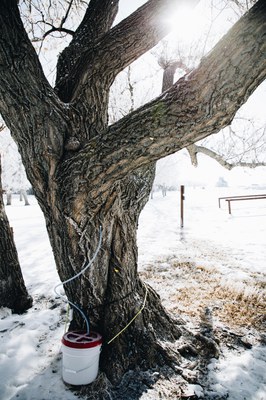Sweet Syrup to Ring in Spring
 Spring can be an exciting time to start getting outside after a long, cold winter in North Dakota. And what better reason than if there is sweet maple syrup as an end result? While we don’t have lush forests of sugar maples (Acer saccharum) like our neighbors to the east, we do have a naturally occurring relative with the boxelder (Acer negundo), which is sometimes referred to as the Manitoba Maple. The final product of boxelder syrup has a very delicious and sweet taste, much like regular natural maple syrup, but with a lighter color and I find a bit of a hint of butterscotch flavoring.
Spring can be an exciting time to start getting outside after a long, cold winter in North Dakota. And what better reason than if there is sweet maple syrup as an end result? While we don’t have lush forests of sugar maples (Acer saccharum) like our neighbors to the east, we do have a naturally occurring relative with the boxelder (Acer negundo), which is sometimes referred to as the Manitoba Maple. The final product of boxelder syrup has a very delicious and sweet taste, much like regular natural maple syrup, but with a lighter color and I find a bit of a hint of butterscotch flavoring.
Although Boxelder trees are naturally occurring in North Dakota in forests and along riparian areas, they can also be commonly found planted in towns, parks, windbreaks, and around homesteads in North Dakota. The first step of your syrup making journey, will be to properly identify a Boxelder tree which can often times be mistaken for other trees like green ash, balsam poplar, or Siberian elm. Next, make sure proper permission is attained before tapping a tree to collect syrup. Different park districts or towns may or may not allow tapping of a public tree.
Boxelder sap starts to flow as air temperatures go back and forth between above freezing during the day to below freezing temperatures at night. This can change when this happens on the calendar each year, but normally early March in the southern half of the state to middle or late March in the northern half of the state. In the Turtle Mountain region in the northern part of the state, I have started tapping and collecting sap from March 1st one year to March 25th the next year. The prolonged winter that North Dakota has seemed to have this year has pushed sap flow even further, so there may still be a chance to collect and make some delicious syrup even into April.
Tapping trees starts with a cordless drill and sharp drill bit the same size as the taps you have. I use a 5/16” bit. It is only necessary to drill in at a very slight upward angle about 1 ½” deep. This will get past the bark and remain in the outer, softer wood where the sap flows. Personally, I use a piece of tape on the drill bit to make sure I go the proper depth. A couple whacks with a rubber mallet from a 3 year old seems to be the proper force to get the tap to stay in without breaking it. Traditionally, metal taps or spires are used, and buckets are hung on the tree. I ordered plastic spires with food grade tubing from an online store and they seem to work well. Buckets are generally used to collect the sap, but I use cleaned water or milk jugs for ease of use.
Once sap starts flowing, my family and I take a hike each day to check and collect what we can. The first few times of collecting are exciting to see what we get and taste the sap straight from the jug. After a few days, a sled or wagon is needed to get the 3 and 6 year old back home from the woods. We tap ten boxelder trees on our land, with a minimum trunk diameter of 12” up to our biggest tree of about 20”.
During the sap run, we keep what we collect each day cool in the shade or in the refrigerator. I don’t like to keep it stored for too long, so I boil each week. There is a difference in clarity and taste with early vs. late season sap collected, but all is delicious on pancakes.
The boiling process can be done on stovetop for small batches, to large stainless steel evaporators over a big fire. I can easily boil down ten gallons of sap from the week with a turkey fryer outside and finish on the stove. Each gallon of sap will boil down to about 4 oz. of finished syrup, so it takes about 30-40 gallons of sap to make each gallon of syrup. To know when syrup is finished, I use a digital food thermometer. In my neck of the woods at an elevation of 2500 feet, the boiling point of water is around 207 degrees Fahrenheit according to my thermometer. Syrup is finished about 7 degrees above boiling temp so I stop once it reaches 214 degrees. Lastly, I filter through cheesecloth or another filter straight into sterile jars while still hot. I then close the lids and wait for them pop to let me know they are sealed and ready for storage. It will be thinner or more watery than some corn syrup based syrup found in grocery stores, but this syrup will have a very rich, sweet taste that can be enjoyed right on pancakes or added as a sweetener while cooking or in a hot tea.
By Mitch Thompson, State Forests Manager, North Dakota Forest Service



